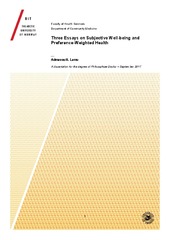Three Essays on Subjective Well-being and Preference-Weighted Health
Permanent lenke
https://hdl.handle.net/10037/12092Åpne
Dato
2018-01-25Type
Doctoral thesisDoktorgradsavhandling
Forfatter
Lamu, Admassu NadewSammendrag
The issue of preference-weighting was examined in Paper 1 in terms of construct validity and level of agreement between preference-weighted and unweighted values for each instrument. The results showed that the preference-weighted and unweighted values performed equally well in terms of both convergent and known-group validities. When the visual analogue scale (VAS) was applied, the correlation coefficients of both preference-weighed and unweighted values were quite large (above 0.60) for each instrument. This thesis showed that both weighted and unweighted measures of the EQ-5D and the 15D showed evidence of knowngroup validity to detect significant differences between known-group variables, such as standard of living and depression. Furthermore, the level of agreement between preferenceweighted and unweighted values was very high in both the EQ-5D and the 15D when the preference-weighted and unweighted values were given on the same scale. This indicates that the importance of preference-weighting is small, at least at the group level.
In Paper 2, the relative importance of health, income, and social relationships was analysed after controlling for socio-demographic variables, such as age, gender, marital status, education level, and employment status, as well as disease and country variables. Five alternative HRQoL measures were applied: four HSU instruments (EQ-5D, short-form six dimensional questionnaire [SF-6D], health utility index mark 3 [HUI3], 15D) and one direct measure of HRQoL (VAS). Depending on which HRQoL measure was applied, all of the aforementioned variables explained about 45-50% of variations in SWB. This implies that the remaining variation could be explained by other omitted variables, such as personality traits and genetic factors. The findings revealed that, in decreasing order of importance, social relationships, health, and income were significantly associated with SWB. The direct measure of HRQoL (VAS) had more influence on SWB than the indirect measures (HSU instruments). Social relationships accounted for nearly half of the total explained variation in SWB, while health accounted for at most one-third. Income accounted for only 7% of the variation, but it was positively significant. The results further revealed that the proportion of effects explained by these variables varied across levels of SWB distributions. The largest contributions were observed at the lower level of SWB.
Results from Paper 3 showed that health influences SWB directly and indirectly via income and social relationships. The effect via income, though significant, was weaker. When measure by the SF-6D, it appeared that more than 50% of the total effect of health was transmitted via social relationships. Thus, the novel finding is that health is important for SWB, but as much for its importance through social relationships.
Forlag
UiT The Arctic University of NorwayUiT Norges arktiske universitet
Serie
ISM skriftserie; 187Metadata
Vis full innførselSamlinger
- Doktorgradsavhandlinger (Helsefak) [770]
- ISM skriftserie [161]
Følgende lisensfil er knyttet til denne innførselen:


 English
English norsk
norsk
